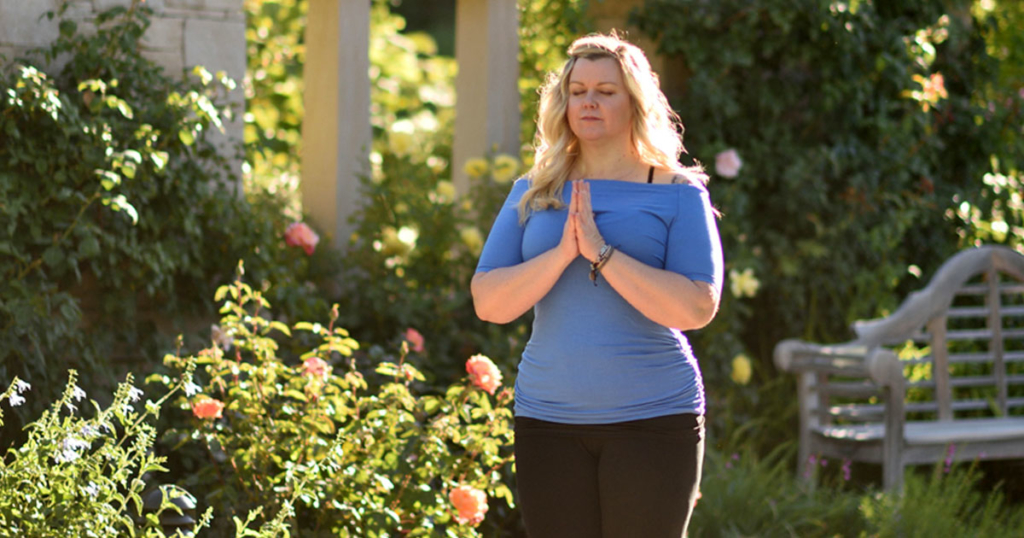
Everybody wants to be happy. So why do so many of us feel dissatisfied? There’s a variety of reasons that we might feel unhappy or unfulfilled. But in my experience, one of the main culprits is expectation. In Western culture, we get the message from an early age that we should achieve certain material and developmental milestones as we move through our lives. We should have a career by the time we’re ____ years of age. We should marry and have x number of children. We should be able to retire comfortably by the time we’re ____. Perhaps we’ve achieved these milestones and yet, dissatisfaction still simmers. The solution is to practice santosha, the yogic principle of cultivating contentment.
Santosha is the second of yoga’s niyamas, the second limb of yoga, according to Patanjali’s yoga sutras. The niyamas are daily practices that help us create a life of ease. In addition to santosha, the niyamas include saucha (cleanliness), tapas (enthusiasm and commitment), svadhyaya (self-study and study of inspiring texts) and ishvara pranidhana (dedication of your practice to something larger than yourself).
Like the yamas (moral/ethical precepts) the niyamas form the foundation of yoga. In the yoga tradition, aspiring yogis practiced the yamas and niyamas before they ever learned asana and pranayama. Once practicing the yamas and niyamas became integrated, the student could move on to the other limbs from a foundation of the wisdom of the first two limbs.
Letting Go of Expectations
Clinging to our expectations, or to cultural expectations, can make us feel that our lives are inadequate. Of course, the desire for our lives to be different can, in some cases, be a catalyst for positive change. So it’s not wrong to orient ourselves in the direction of specific goals.
The problem comes when we expect the our lives to look a certain way, because when they don’t, we can never be satisfied. Truth is, sometimes our achievements, while they may look different from our original vision, may turn out even better than we’d imagined. But if we’re clinging to our expectations, we often can’t appreciate it.
It’s okay to envision how you want your life to look, as long as you remain open to appreciating how it actually turns out. This can help us cultivate santosha.
Gratitude and Santosha
One of the most powerful ways to cultivate santosha is to practice gratitude. When we remember the blessings in our own lives, it’s much easier to touch into contentment. Even when life is challenging, there are always things to be grateful for—a roof over our heads, clean water, nourishing food, a special friend or family member (human or non-human).
Several years ago, a friend of mine died of cancer. A former biker, hiker and cross-country skier, she was bedridden for the last six months of her life. Still, she could find joy in a shared meal, the garden outside her window, or the music some friends and I played for her in her room. She endured great suffering as well, but gratitude for her cherished friendships provided periodic relief from her challenges.
One of the common ways to cultivate gratitude—and santosha— is to keep a gratitude journal. It’s very simple. Each day, write down five things in your life for which you are grateful. These can be anything—big or small. You don’t have to try to come up with different things every day. But do reflect on each one, for a few moments or longer, and on the feeling of gratitude.
Santosha on the Yoga Mat
If you’re reading this, you probably practice yoga. If that’s true, you can practice gratitude for your own body. We all come into the world with different genetics. Some of us are tall; others are short. Some are lean; others are more round. Some of us have dark skin and hair; others are light. Some are strong; others are flexible. You get the idea. The mere fact that you can practice yoga is a gift, no matter what your poses look like.
Your poses do not have to look like the yoga photos on Instagram. Performance is not the point. The point is how your practice makes you feel. We cultivate santosha when we stop worrying about how our poses look, and tune into how practice enhances our lives.
When you practice, pay attention to how you feel while you’re in a pose. Make adjustments so that you can breathe freely, and so that you can relax into your pose. Remember that the relaxation of effort is the traditional definition of mastery in asana practice.
After you leave each pose, pause for a few breaths to take in the aftereffects. Gift yourself with a 10- to 15-minute Savasana (Relaxation Pose). Take a minute or two after Savasana to sit quietly and enjoy the residue of your practice.
